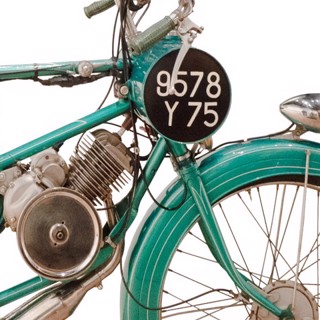Greer Wilkins | Out of Two | Oil on Canvas | 20 x 24 x 2 in | $2,000
In this article, we explore the intersection of classic craftsmanship and visual storytelling. This time, we turn our attention to the Derny Cyclotandem—a rare tandem motorized bicycle with a rich history of innovation—and the striking oil paintings of Greer Wilkins. Both capture a sense of timeless style and purpose, where design meets cultural legacy.
Greer Wilkins’ oil paintings are a masterclass in realism, blending technical precision with a deep reverence for the subjects she portrays. “A majority of what I have been exploring recently revolves around what I can accomplish technically with this new medium in my arsenal: oil paint,” Wilkins explains.
Greer Wilkins | Out of Two (detail image)
“Realism implies an intense amount of time was dedicated to observing and creating; I believe this is essential to moving forward in my works as I want to render figures and items close enough to life that a viewer gets stuck looking for brushstrokes and is forced to confront the painting in such intimate proximity.”
This commitment to realism is evident in Wilkins’ still lifes, where she transforms everyday objects into mesmerizing focal points. A bird perched lightly on the rim of a porcelain teacup, the iridescence of a butterfly’s wing catching the light, the translucence of a flower petal—each painting invites viewers to linger, searching for the evidence of the artist’s hand.
Greer Wilkins | Conundrum | Oil on Canvas | 24 x 20 x 2 in | $2,000
Her ability to achieve this level of detail is not just a testament to her skill but also to her profound dedication to the process of seeing. Every subject she paints is deeply observed, studied, and then brought to life through meticulous layering and an acute sensitivity to light, texture, and form.
Wilkins’ approach parallels the craftsmanship and precision found in the engineering of the 1950 Derny Cyclotandem, a motorized pacing bicycle designed to maintain rhythm and control. Just as Wilkins’ paintings compel a viewer to slow down and engage with their intricacy, the Derny was built to set a steady pace, ensuring endurance and stability rather than reckless speed. Its teal frame, woven basket, and carefully placed mechanics reflect an era where function and aesthetics were inseparable—where every detail mattered.
Derny Cyclotandem, 1950 | Zurcher; air-cooled, 98cc single-cylinder, 2-stroke | on Loan with the Lane Motor Museum
The name Derny is legendary in the world of bicycle racing, closely associated with the motorized pacing vehicles that revolutionized the sport. Originating in France in the 1930s, Derny introduced its first model, the Entraineur, in 1938, specifically designed to pace cyclists in endurance races like the Bordeaux-Paris. What set these French machines apart was their innovative design, featuring a distinctive cylindrical fuel tank under the handlebars and a specialized gearbox, clutch, and flywheel that ensured a smooth, consistent pace—crucial for professional racers.


In 1939, Derny expanded beyond racing with a civilian model, making motorized cycling more accessible. After a wartime pause, the company resumed production in 1949 with the Cyclotandem, a two-person motorized bicycle powered by a Zurcher engine. This 1950 Cyclotandem model was once owned and ridden by the renowned French cyclist Marcel Leyat, who often rode with his daughter. Known for its unmistakable loud, straight-cut gear transmission, the Cyclotandem became a favorite among cycling enthusiasts.
While Wilkins captures fleeting natural beauty in her oil paintings, the Derny represents movement itself—yet both are anchored in history and tradition. They remind us that whether through a finely detailed brushstroke or a perfectly tuned motor, artistry exists in many forms. One invites us to look closer, the other to move forward, but both tell stories of craftsmanship, nostalgia, and the enduring beauty of balance.
